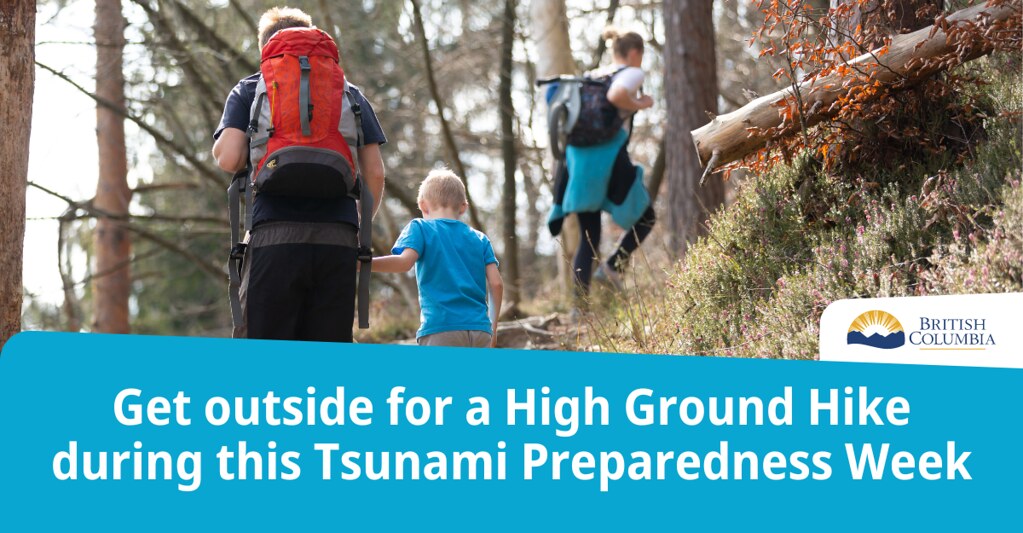
Tsunami Preparedness Week: B.C. urges residents to be ready in case disaster strikes
April 10, 2023
By
OHS Canada

Photo: B.C. Government
People on the coast of British Columbia are being reminded of the danger posed by tsunamis and to be prepared in case disaster strikes.
This week, April 9 to 15, is Tsunami Preparedness Week.
“We know it’s scary to think about emergencies like tsunamis, but by getting prepared and learning about the tsunami risk in your community now, you’ll be safer in the event of a tsunami,” said Bowinn Ma, Minister of Emergency Management and Climate Readiness. “Tsunami Preparedness Week is the perfect time to put together an emergency kit for your family and practise evacuating to a tsunami-safe location in your community.”
Some coastal communities are hosting High Ground Hikes during Tsunami Preparedness Week to raise awareness about B.C.’s tsunami risk. During these events people will practise reaching their tsunami-safe location. Knowing where high ground is and how to get there is an important part of tsunami preparedness. Some people may not need to travel far to reach safety.
This year, High Ground Hikes will be held in the following communities:
- Colwood;
- Gold River;
- Heiltsuk Nation (Bella Bella);
- Mount Waddington Regional District – Quatsino;
- Old Massett;
- Pacheedaht First Nation;
- Piers Island (during Emergency Preparedness Week in May);
- Port Hardy;
- Port Moody;
- Prince Rupert;
- Sooke;
- Stewart;
- Tofino;
- Toquaht Nation;
- Ucluelet; and
- Victoria.
“It’s so important that people on the coast are ready and know what to do when a tsunami occurs. Many communities – including some here in the north Island – are hosting a High Ground Hike, which is great way to practise your evacuation plan,” said Michele Babchuk, MLA for North Island. “I also encourage everyone in risk areas to learn about local public alerting and put together an emergency grab-and-go bag for your family.”
In the event of a tsunami, which is a giant wave caused by earthquakes beneath the ocean, landslides or volcanic eruptions, people in an affected area will receive a tsunami alert that will be broadcast across television, radio and compatible mobile devices through B.C.’s emergency-alert system.
Preparation tips
To prepare before a tsunami occurs:
- Become familiar with local evacuation routes and high ground locations.
- For people near the coast when an earthquake occurs, drop, cover and hold on, and then move to higher ground immediately.
- Once at high ground, stay there. Wait for the “all clear” from local officials to confirm the threat is over. Tsunami waves can last several hours.
- Find out how your community will share emergency information and subscribe to local alerts. Alerting methods include radio, television, telephone, text messages, door-to-door contact, social media and outdoor sirens. Always follow instructions from local officials during an emergency.
- If you are not in a tsunami zone, stay home and connect with family, friends and neighbours who are in a potential tsunami zone.
- If you are visiting an area with higher tsunami risk, research evaluation routes and share your travel plans with friends and family.
Quick facts
- The Ministry of Emergency Management and Climate Readiness issues emergency alerts on behalf of the Province and relies on several alerting systems in the event of a tsunami.
- There are local government emergency alerts, coastal siren systems, door-to-door notifications, social media and the National Public Alerting System, publicly branded as Alert Ready.
- In 2022, the Province, in partnership with the Capital Regional District, launched the Capital Region Tsunami Information Portal, which shows people if they are living or working in or visiting a tsunami hazard zone.
- In January 2023, Natural Resources Canada installed the 100th Early Earthquake Warning (EEW) sensor in B.C., and the Province announced in January 2023 that as many as 50 more sensors are being installed.
- EEW systems rapidly detect an earthquake and provide seconds of notice before strong shaking begins.
- The system will be operational by spring 2024.
Learn more
Read or download the PreparedBC Earthquake and Tsunami Preparedness Guide, which has been translated into French, simplified Chinese, traditional Chinese and Punjabi: www.PreparedBC.Ca/tsunamis
For information about tsunami risks and how to get prepared, visit: www.PreparedBC.Ca/tsunamis
For more information about how to prepare for an emergency and what to include in emergency kits, visit: PreparedBC.ca